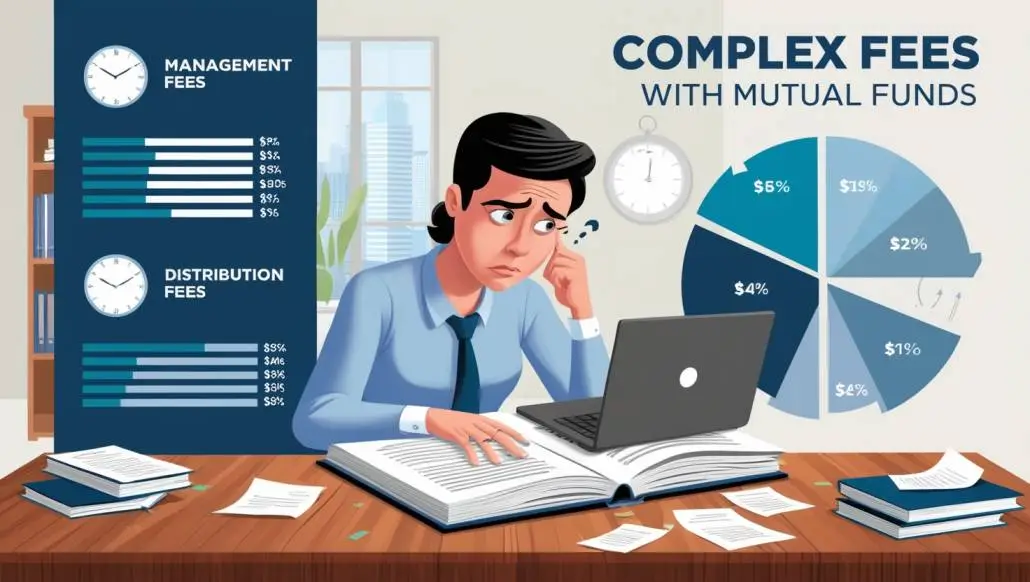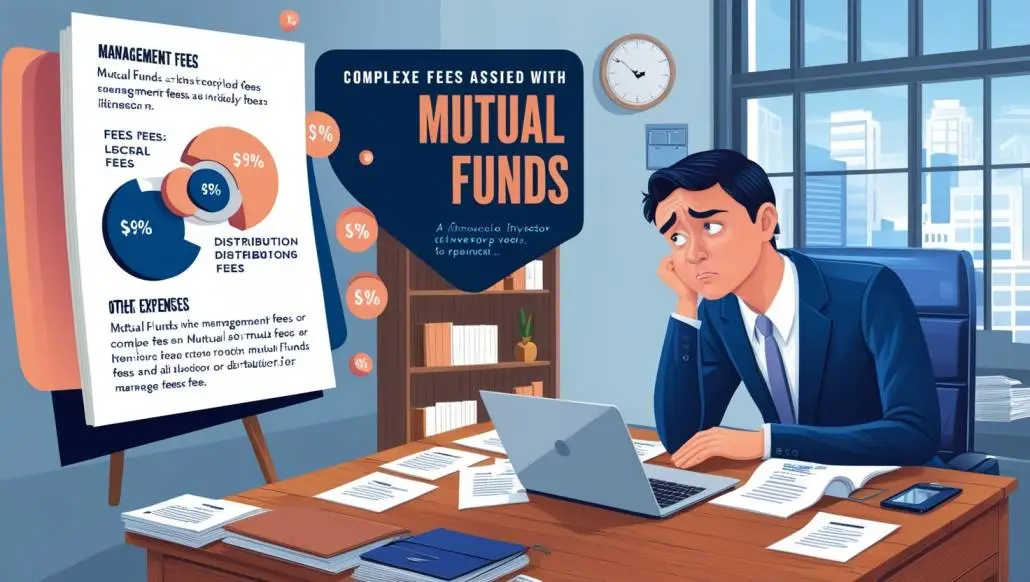Introduction to Mutual Fund Fees
When you start with mutual funds, fees are key. They might seem small, but they can affect your earnings. So, why do these fees exist, and how do they impact your investments?
Why Understanding Fees Matters
Think of mutual fund fees like tolls on a highway. Each fee cuts down your earnings. Knowing what to expect helps you make better choices to boost your profits.
Overview of Common Fee Types
Mutual fund fees are varied. Some are clear, others not so much. Common types include the expense ratio, sales loads, and maintenance fees. Let’s dive into each one.

Types of Fees in Mutual Funds
Expense Ratio
The expense ratio is the yearly cost of running the fund. It’s a percentage of the fund’s assets. It covers management, administrative, and other fees.
Management Fees
These fees pay the fund manager for their work. They get paid for their expertise and effort.
Administrative Costs
Administrative fees handle daily tasks like record-keeping and legal stuff.
Sales Load
Sales loads are commissions for selling the fund. They include:
Front-End Load
This fee is paid when you buy the fund. It lowers your initial investment.
Back-End Load (Contingent Deferred Sales Charge)
This fee is applied when you sell shares. It decreases as you stay invested longer.
Redemption Fees
Redemption fees are charged for selling shares early. They discourage quick trading.
Exchange Fees
Some funds charge a fee for switching funds within the same family.
Account Maintenance Fees
These fees are for keeping your account active. They’re often waived if you keep a minimum balance.

How Fees Are Charged
Ongoing Fees
Ongoing fees, like the expense ratio, are taken annually. They affect the fund’s performance.
One-Time Fees
One-time fees, such as sales loads, happen during transactions. They’re paid when you buy or sell shares.
Impact of Fees on Your Investments
Compounding Costs Over Time
Even small fees can grow over time. A 1% fee can cost thousands over decades.
Comparing Low-Cost vs. High-Cost Funds
Lower-fee funds often do better than higher-fee ones. Choosing a low-cost fund can greatly improve your returns.
Strategies to Minimize Mutual Fund Fees
Choose No-Load Funds
No-load funds don’t charge sales commissions. They’re a cost-effective choice.
Focus on Low Expense Ratios
Look for funds with low expense ratios. Compare them to find the best deals.
Avoid Frequent Trading
Frequent trading adds extra costs. This includes redemption and exchange fees.
Fee Structures Across Fund Types
Actively Managed Funds
These funds have higher fees. They’re managed actively by professionals.
Index Funds
Index funds are passively managed. They usually have lower fees, making them good for those watching their budget.
ETFs (Exchange-Traded Funds)
ETFs often have lower fees and no sales loads. They’re great for those who want to save money.
Regulatory Disclosures and Transparency
How Fees Are Disclosed
Mutual fund fees are shown in the fund’s prospectus. It gives a clear list of costs.
Understanding the Prospectus
The prospectus is key for knowing a fund’s fees, goals, and past results.
Common Misconceptions About Mutual Fund Fees
Are Higher Fees Always Better?
No, higher fees don’t mean better returns. They just show more management effort.
Hidden Costs to Watch Out For
Watch for hidden costs like transaction fees and taxes. They can cut into your earnings.
Final Thoughts on Managing Mutual Fund Costs
Knowing about mutual fund fees is key to better investing. By picking funds with lower fees, you keep more money. Always read the prospectus and talk to a financial advisor for advice.
FAQs
What is the average expense ratio for mutual funds?
The average expense ratio is between 0.50% and 1.50%. It depends on the fund type and management style.
Are no-load funds completely free?
No-load funds don’t have sales loads. But, they might have expense ratios and other fees.
How do mutual fund fees compare with ETF fees?
ETFs usually have lower fees than mutual funds. This is especially true for actively managed funds.
Can fees vary based on the fund’s performance?
No, mutual fund fees stay the same. They don’t change with the fund’s performance.
Where can I find detailed fee information for a mutual fund?
You can find detailed fee info in the fund’s prospectus. The fund company gives it.


